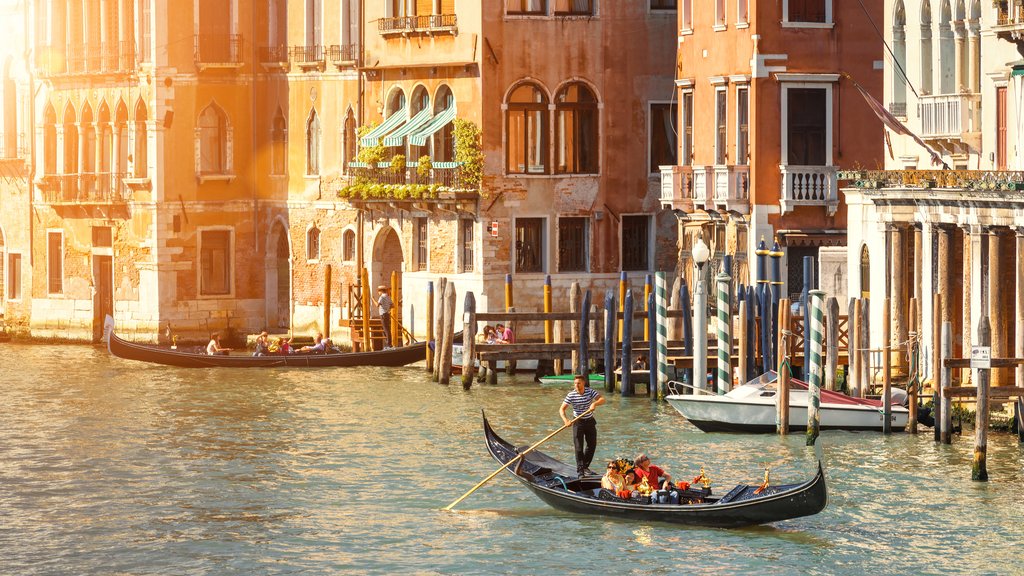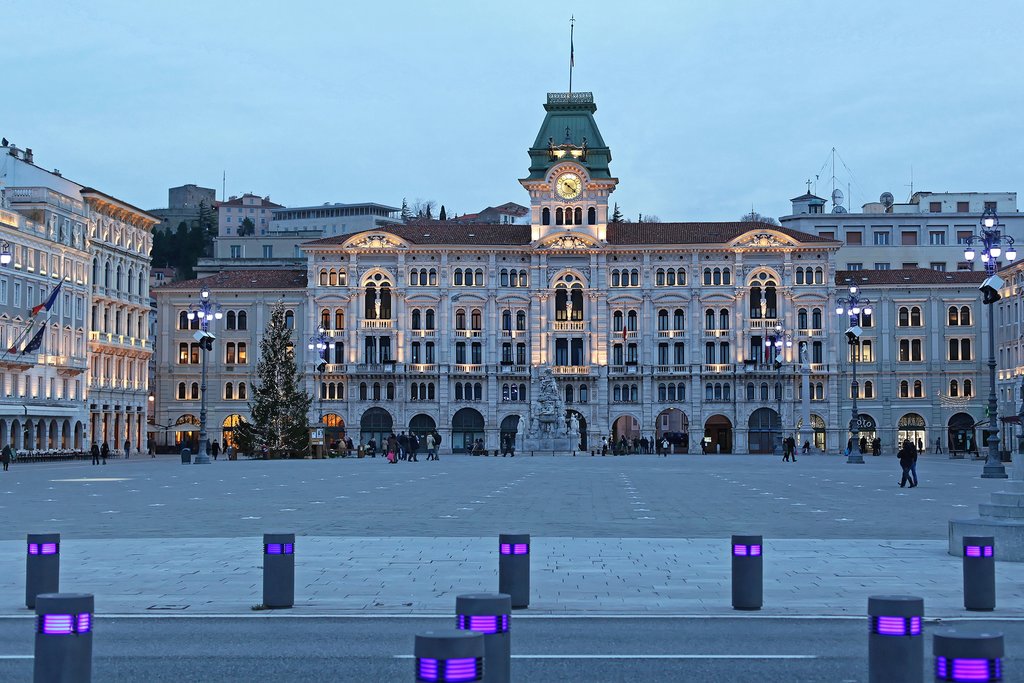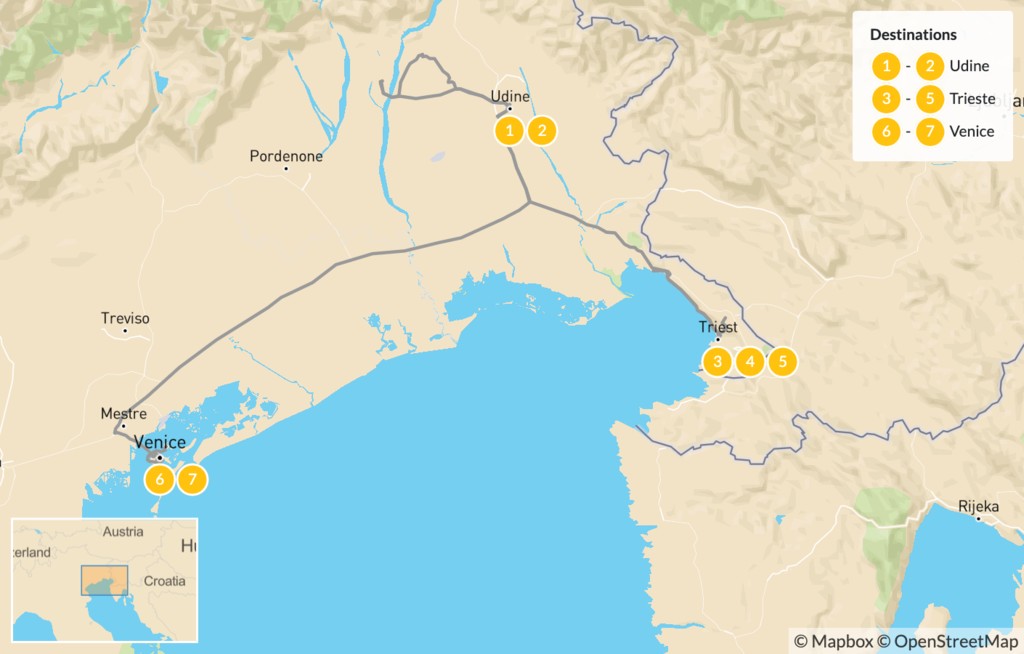Highlights
- Tour the historic streets of Trieste
- Hike along the ancient towns of the Carso Ridge
- Meet Venetian artisans in Murano and Burano
Brief Itinerary
| Day | Highlights | Overnight |
|---|---|---|
| Day 1 | Arrive in Venice, Transfer to Udine | Udine |
| Day 2 | Spilimbergo Tour, Mosaic Workshop, & Prosciutto in San Daniele | Udine |
| Day 3 | Transfer from Udine to Trieste | Trieste |
| Day 4 | Tour of Trieste | Trieste |
| Day 5 | Hiking Tour of Carso Ridge | Trieste |
| Day 6 | Transfer to Venice, City Tour | Venice |
| Day 7 | Murano, Burano & Torcello Excursion | Venice |
| Day 8 | Goodbye, Italy |
Detailed Itinerary
Day 1: Arrive in Venice, Transfer to Udine

Welcome to Italy! Arrive in Venice International Airport, then transfer to Udine by high-speed train. You'll be met by your tour representative who will help you check in and answer any questions you have about the week ahead.
Udine lies in the autonomous region of Friuli Venezia Giulia, in the north of Italy. It's surrounded by Austria to the north and Slovenia to the east. Thanks to the region's strategic position on the Adriatic Sea, it's a major travel corridor for Southern Europe's trading routes. The region is diverse with a cultural mix of Italian, Austrian, Slovene, and other international influences. Multiple languages are spoken here, including Friulian and several other local dialects.
The city of Udine has a distinct Venetian charm and a historic downtown characterized by medieval buildings, Venitian piazzas, and open-air cafes. The Piazza Libertà is known as "the most beautiful Venetian square on the mainland," and the Piazza Matteotti is a popular gathering spot with locals and visitors. The piazza is surrounded by covered porticos which lend it the vibe of an open-air lounge, and the nearby cafes are a great place to enjoy a coffee and people-watch.
In the 18th century, the town was home to the legendary artist Giambattista Tiepolo, whose famed rococo masterpieces are displayed in the Gallerie del Tiepolo, Duomo, and in the Chiesa della Purità.
After you've settled in, head out for a guided tour of the city to explore its Venetian architecture and lively piazzas. Start at the Piazza Libertà to see the Loggia del Lionello, an impressive 15th-century Venetian Gothic building that bears a strong resemblance to Venice's Doge's Palace. Across the piazza stands the clock tower (Torre dell' Orologio), which was built in the 16th century by Giovanni da Udine.
Continue down the main avenues to see the 14th-century Cathedral and the Oratorio della Purità, an 18th-century institution built for the religious education of young girls and women.
Your next stop is the hill in the middle of town, to reach Udine Castle. From here, the views of the town, peaceful countryside, and the snow-capped Alps are breathtaking.
In the afternoon, spend a few hours learning about Udine's history and culture from one of the city's many museums and churches. Chiesa di San Giacomo, Arco Bollani, the Museum of Modern and Contemporary Art, Museo Etnografico dei Friuli, and Lignano Sabbiadoro are all great options.
If you're in the mood for shopping, check out Via Mercatovecchio, Via Rialto, or Piazza XX Settembre.
In the evening stoll along Piazza del Duomo, Piazza Giacomo Matteotti, Via Vittorio Veneto, or Via Poscolle for plentiful dinner options.
Day 2: Spilimbergo Tour, Mosaic Workshop, & Prosciutto in San Daniele

Today's half-day trip is a combination of art and food—two areas where Italy excels. Start your day with a visit to Spilimbergo. Tour the medieval town center and visit the Castello di Spilimbergo to see colorful frescoes painted on the exterior walls of the 15th-century Palazzo Dipinto (Painted Castle).
Continue to the 14th-century loggia, which once housed goods and wares in medieval times, and the 13th-century Palazzo del Daziario (Duty Palace), which once housed the magistrates. You'll also see the 14th-century Cathedral, one of Friuli's most notable Gothic buildings. Inside, beautiful frescoes depicting scenes from the New and Old Testaments adorn the ceiling.
No visit to Spilimbergo would be complete without a visit to the Scuola Mosaicisti del Friuli, the only professional school of mosaic art in the world. Colorful tiles decorate the walls, and the light and movement of the mosaics make the artwork come to life.
After your tour, try your hand at crafting your own mosaic. Follow the instructions of a mosaic Maestro as you learn about classical and modern mosaics and immerse yourself fully into the ages-old craft.
In the afternoon, head to the nearby town of San Daniele del Friuli. Your main stop here is a prosciutto producer to learn about local pig breeds and see how fresh haunches are turned into San Daniele hams. Tour the temperature-regulated cellars, as well as the final aging cellars to see where hundreds of hams await inspection and branding. Following the tour enjoy a prosciutto tasting and savor one of Italy's finest delicacies.
Day 3: Transfer from Udine to Trieste

In the morning, take the train to Trieste, then transfer to your hotel.
Trieste is an ancient city whose recorded habitation dates back to the second millennium BCE. The original name, Tergeste, comes from the Venetic word meaning 'market'. Later, Trieste became part of the Roman republic in 177 BC during the Second Istrian War. For the next 2,000 years, the city was largely prosperous and became a major trading hub until 1918 when Italy took control of the city.
During this time Trieste was a major cosmopolitan center for culture and literature in the Austrian Riviera and was frequented by artists and philosophers such as James Joyce, Italo Svevo, Sigmund Freud, Zofka Kveder, and Dragotin Kette. The 20th century brought unrest into the city, as the Italian lower class sought to wrest power from the middle-class Slovenes. As a result, many ethnic Germans and Slovenes left Trieste, while ethnic Italians from newly-formed Yugoslavia relocated to Trieste. Around the time of World War II, Trieste's large Jewish population (Italy's third-largest at the time), as well as many Slavs and anti-fascist Italians were systematically exterminated, many at the Risiera—the only concentration camp built on Italian soil.
Today the city is a thriving economic and cultural hub, primarily as a coffee shipping hub for the rest of Italy (Trieste supplies more than 40% of Italy's coffee). Grand cafès, wide avenues, beautiful tree-lined parks, and a vibrant cultural scene make it a beautiful travel destination.
In the afternoon, head out for a leisurely stroll along the waterfront to explore the city sights on your own, then stop by a cafe for a relaxed meal.
Recommended places to visit:
- Castello di Miramare & the gardens
- Castello di San Giusto
- Chiesa di Santo Spiridione
- Chiesa di Sant'Antonio Taumaturgo
- Piazza dell'Unita' d'Italia
- Trieste Roman Theatre
- Molo Audace
- Piazza della Borsa
- Borgo Teresiano
- Trieste Market
- Teatro Verdi
- Canale Grande
- Trieste harbour
- Piazza Venezia
- Grotta Gigante
- Civico Museo Sartorio
- Museo Revoltella
- Museo Joyce & Svevo
- Statue of James Joyce, Statue of Italo Svevo
- Museo della Comunita' Ebraica Carlo e Vera Wagner
- Civico Museo Teatrale Carlo Schmidl
- Museo del Mare
Chat with a local specialist who can help organize your trip.
Day 4: Tour of Trieste

Today's small-group tour is the perfect way to get to know the city of Trieste. The tour starts in the Old Town, home to the city's oldest neighborhoods and shops. Antique dealers, bookshops, potters, framers, and art galleries line the narrow city streets. Nearby, the ruins of the Roman Theater and Augustan Triumphal Arch offer a window into the city's past.
From here, walk along Trieste's elegant seafront to admire exquisitely constructed Neo-Classical palaces. You'll reach Piazza Unità d’Italia, site of the Town Hall and Italy's largest seafront square. Continue to see the Teatro Verdi Opera House (a mix of Milan's La Scala and Venice's La Fenice, as both architects helped design the building) and the Piazza della Borsa with its stunning Stock Exchange Palace.
Your tour of Trieste continues through the Theresian district, which gets its name from Maria Teresa, Austria's much-loved Empress. This neighborhood is also home to the palace-lined Grand Canal, St. Anthony's Church, the adjacent Serbian-Orthodox Church, and the bronze statue of James Joyce over the Ponterosso bridge.
Enjoy a leisurely lunch, then continue your tour to see the Miramare Castle, which sits directly on the seafront and is surrounded by beautifully landscaped gardens and botanic gardens. Stroll through the romantic residence of Maximilian of Hapsburg and Charlotte of Belgium to see the different native and exotic plant species. The castle is the perfect place to spend the afternoon enjoying the panoramic views of the surrounding sea from its perch high on the cliff.
Day 5: Hiking Tour of Carso Ridge

Take in the beautiful nature, sweeping views, and quiet villages on today's half- to full-day walk through the countryside. Start your day with an 8:30 AM pick up from your accommodation in Trieste, then head out to the Carso Plateau to explore the landscape on foot. Spend the day walking from Duino to Opicina along old roads and trails and learning about local biodiversity. Frequent stops in villages along the way for coffee and food round out this laid-back tour.
The hike is easy-going, and you won't need technical clothing to enjoy the day. Wear comfortable walking shoes and bring a camera to make the most of today's hike. Follow the old trail along the Carso Ridge, which used to link the ancient villages of Ceroglie, Malchina, Prepotto, San Pelagio, Ternova, Samatorza, Sales, Sgonico, Rupingrande, and Opicina.
As you walk, learn about the unique Carso (Karst) environment, and how the word became the scientific term for similar land formations around the world. Breathe in the fresh countryside air as you stroll through meadows dotted with red sumac, along the Istria seafront and Grado lagoon, and on high ridges overlooking the coast.
Today's hike is fully customizable, from short 1.9-mile (3 km) walks to 9.3-mile (15 km) hikes. The maximum duration is approximately 9 hours.
Day 6: Transfer to Venice, City Tour

NEEDS EDITS
Welcome to Itay! Arrive in Venice Airport, then transfer to the city center. Once in the city, a water taxi will transport you to the town center and your hotel.
Venice in northern Italy is famous for both industry and tourism. With nicknames like "Queen of the Adriatic", "City of Water", and "The Floating City", it's clear that the city's myriad canals are its main draw. Stretching across 117 small islands in the marshy Venetian Lagoon along the Adriatic Sea, the city has long been a commercial and cultural hub thanks to its strategic placement. Silk, grains, spices, and art were traded through the Middle Ages, making Venice very wealthy.
Venice is well known for several artistic movements, particularly from the Renaissance period. The city's many musicians, like Antonio Vivaldi and others, played important roles in the shaping of symphonic and operatic music. Numerous artists have called Venice home, and their work continues to draw visitors worldwide.
The city is also famous for its many beautiful historic attractions, such as the Piazza San Marco and San Marco Basilica, the Grand Canal, and the ornate Doge's Palace. The Lido de Venezia is a popular luxury destination that attracts actors, critics, and other cinema industry celebrities.
Depending on when you arrive, a great introduction to the city is to take a romantic cruise down Venice's canals on a historic gondola to see stunning architecture and narrow waterways. This is not a guided tour but rather a relaxing cruise that allows you to take in the amazing city from the water.
In the afternoon and evening, head out for a private guided walking tour of the city's top sights. Start at Piazza San Marco (St. Mark's Square), the heart of the city's cultural and administrative district. The piazza is also home to the Palazzo Ducale (Doge's Palace), a Venetian Gothic palace built as the primary residence for the Doge of Venice in 1340.
Adjacent to the palace is the San Marco's Basilica, originally the Doge's personal chapel. The building is one of the best surviving examples of Italo-Byzantine architecture and features a stunning collection of Byzantine art, gold mosaics, and exquisite marble floors.
The palace is also connected to the next-door prison by the infamous Bridge of Sighs, which has joined the two buildings since the 16th century. The bridge features a small window onto Venice's harbor and earned its grisly name from the prisoners' sighing as they got one last glimpse of the city on their way to execution. While most visitors gather outside the bridge to look in, you'll get the best sense of history from inside the bridge, looking out from the same window as the doomed medieval prisoners.
Day 7: Murano, Burano & Torcello Excursion

Head out for a tour of Venice's three famous neighbors—the islands of Murano, Burano, and Torcello. Begin your boat and walking tour aboard a motorboat en route to Murano, passing the island of San Giorgio Maggiore, the tip of Sant'Elena and the Lido. Tour Murano, which is famous for its colorful glass-making. Visit a glass blower to learn about the process and marvel at the intricate pieces, including elaborate chandeliers.
From here continue to Burano, a picture-perfect island known for its colorful houses and elegant lacework. You'll have time to explore the island before the short boat trip to nearby Torcello to see the ancient cathedral with its fine mosaic inlays, followed by a visit to the Church of Santa Fosca.
After spending a full day enjoying the sights and sounds of the unique islands, return to Venice by boat in time for a relaxed evening in a neighborhood restaurant.
Day 8: Goodbye, Italy

After one last cappuccino over breakfast, head to the airport for your connecting flight home. Have a good trip!


